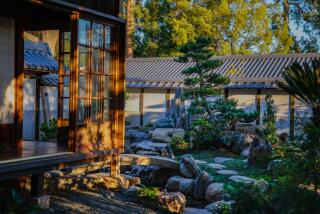Kisho Kurokawa, 73; influential Japanese architect who designed adaptable structures
- Share via
TOKYO — Kisho Kurokawa, one of postwar Japan’s most influential architects whose legacy was a philosophy as much as a collection of buildings, died Friday of heart failure in a Tokyo hospital. He was 73.
Kurokawa was the youngest founding member of the Metabolism Movement, which emerged in Japan on the cusp of the 1960s and bloomed most spectacularly during the Osaka Expo of 1970. The Metabolists advocated a renewable form of architecture in which buildings, or parts of them, could be adaptable and replaceable.
But Kurokawa never lost his reverence for the delicacy of traditional Japanese influences. Even as his designs embraced abstract geometrical forms, he insisted they retain an often-invisible thread of Eastern aesthetics.
The approach was consistent with his theory of “symbiosis,” which drove him to design structures that accommodated different theories, diverse cultures and clashing personalities.
That philosophy was displayed in designs such as the replaceable pods of the Nakagin Capsule Tower built in Tokyo in 1972 and the Kuala Lumpur International Airport, which incorporated a transplanted tropical rain forest into a design based on abstract Islamic domes.
Kurokawa’s architectural fingerprint remains visible from Paris to Beijing and Astana, the new capital of Kazakhstan, for which he designed a master plan in the 1990s.
His only American work is the Sporting Club in Chicago’s Illinois Center.
The son of an architect, Kurokawa was born in Nagoya, Japan, in 1934 and, as a child, witnessed the razing of the city’s wooden buildings by American bombers. In later interviews, he frequently referred to the powerful impact that staggering destruction had on him, saying it helped shape his belief in architecture that sought to move from “the age of the machine” to the “age of life.”
The aerial attacks on Japanese cities such as Nagoya led Kurokawa’s family to send him to live outside of the city with his grandfather. Kurokawa lived in the tearoom of his grandfather’s house, according to Dana Buntrock, a professor at UC Berkeley who has lived extensively in Japan and writes on postwar Japanese architects.
“The exquisite sensibility of that tearoom became intuitive to him,” she said.
But Kurokawa was also among the first architects to embrace the use of computers in design. The desire to “blend those poles, the scientific and the historical,” became a signature of his work, Buntrock said.
Kurokawa’s early education also inculcated him in Buddhist theory. He credited Buddhism’s tolerance for promoting the belief that different elements and styles can coexist in architecture while retaining their individual identities.
He acknowledged that this belief in cultural diversity marked a break from conventional Japanese views of harmony, in which individual identities are erased by the need for compromise.
Kurokawa’s early career was more noteworthy for his prolific writings on theory and philosophy than on building. He earned architecture degrees from Kyoto University and Tokyo University and, although his first commission was a small house in Japan, he spent much of the 1960s designing concepts that never got built. Another of his first commissions was for a pear canning factory.
But his small architectural firm founded in 1962 gradually moved from the theoretical to the practical. His concepts of houses floating on a lake and a tower patterned on DNA molecules were complemented by earthbound projects such as a resort in Yamagata called Hawaii Dreamland.
If there was a breakthrough moment, it came with the Osaka Expo of 1970 that showcased three Kurokawa buildings. A year later he was a finalist in the competition for Paris’ famous Pompidou Centre.
Unleashed in Japan, he designed the landmark Sony Tower in Osaka (1976) and left his mark across the country with such notable buildings as the National Ethnological Museum in Osaka (1977) and the Hiroshima City Museum of Contemporary Art (1989).
By the 1990s he also was designing abroad, including the Chinese-Japanese Youth Center in Beijing (1990) and the stone and titanium New Wing of Amsterdam’s Van Gogh Museum (1998) that was underwritten by a wealthy Japanese businessman and art collector.
Kurokawa continued to design extensively across Asia until his death, notably in China where he claimed a friendship with President Hu Jintao. His last major Japanese project was the recently opened National Arts Center in the Roppongi district of Tokyo, with its curtain-like facade.
But in his final year, Kurokawa also attracted attention with his quixotic, late-in-life decision to enter active politics. In April he ran for governor of Tokyo, one of the most powerful political jobs in Japan, and lost to his longtime friend Shintaro Ishihara.
Kurokawa said he could no longer accept the brash Ishihara’s slurs against the Chinese and Koreans, contending that they embarrassed Japan. He also opposed Ishihara’s bid to bring the 2016 Summer Olympics to Tokyo, arguing the Games would impose too great a strain on the capital’s infrastructure.
Kurokawa then ran and lost in elections for the upper house of Japan’s parliament in July. His losing streak was furthered by news that the current owners of one of his defining buildings, the Nakagin Capsule Tower, planned to tear it down. Kurokawa, who had planned for the tower to survive by replacing its individual capsules every 25 or 30 years, fought unsuccessfully against the demolition.
He is survived by his wife, Akayo Wakao, a well-known Japanese film actress, and their two children.
--
More to Read
The biggest entertainment stories
Get our big stories about Hollywood, film, television, music, arts, culture and more right in your inbox as soon as they publish.
You may occasionally receive promotional content from the Los Angeles Times.










